-
2020
During quarantine I collected many humorous memes about staying at home and the problems that brought. All sorts of subjects were covered: cooking, getting along with your spouse/roommates, homeschooling the kids, learning to bake bread, being stuck at home, sanitizing, facemasks, people hoarding toilet paper, boredom, effects of isolation, etc. Here are a few of those memes.
-
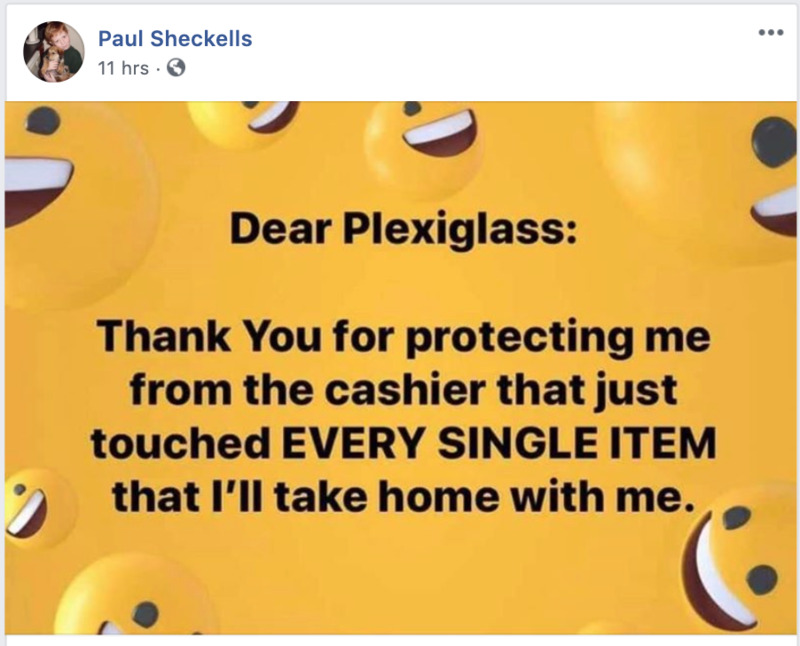
2020
During quarantine I collected many humorous memes about staying at home and the problems that brought. All sorts of subjects were covered: cooking, getting along with your spouse/roommates, homeschooling the kids, learning to bake bread, being stuck at home, sanitizing, facemasks, people hoarding toilet paper, boredom, effects of isolation, etc. Here are a few of those memes.
-
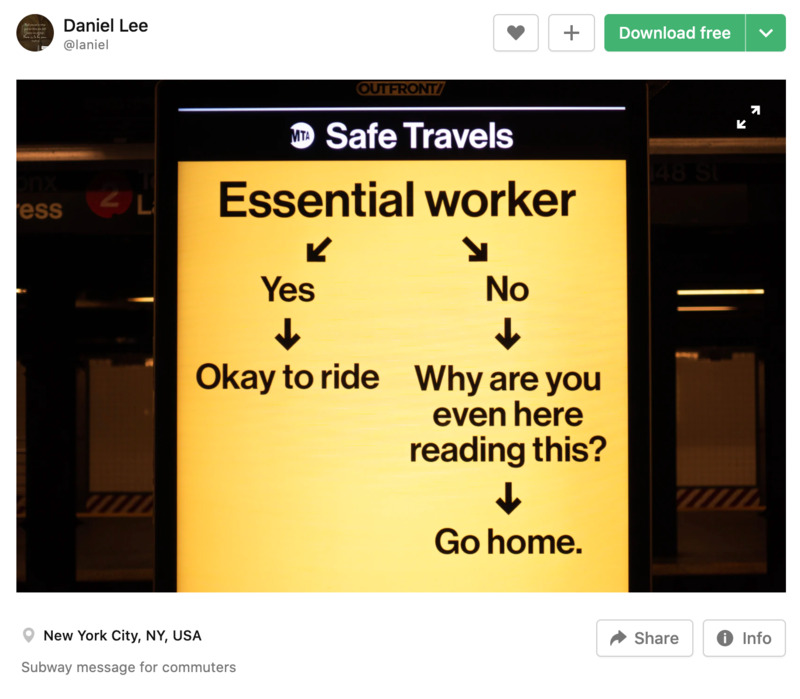
2020
During quarantine I collected many humorous memes about staying at home and the problems that brought. All sorts of subjects were covered: cooking, getting along with your spouse/roommates, homeschooling the kids, learning to bake bread, being stuck at home, sanitizing, facemasks, people hoarding toilet paper, boredom, effects of isolation, etc. Here are a few of those memes.
-
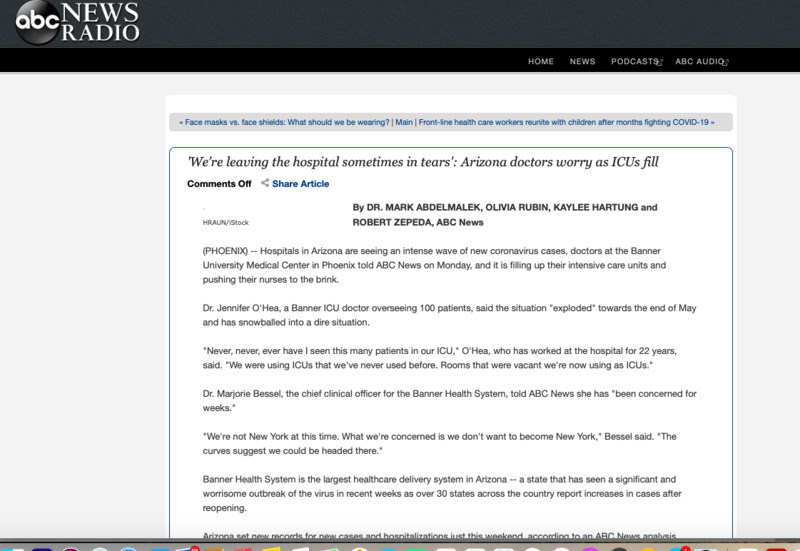
2020-06-30
(PHOENIX) -- Hospitals in Arizona are seeing an intense wave of new coronavirus cases, doctors at the Banner University Medical Center in Phoenix told ABC News on Monday, and it is filling up their intensive care units and pushing their nurses to the brink.
-
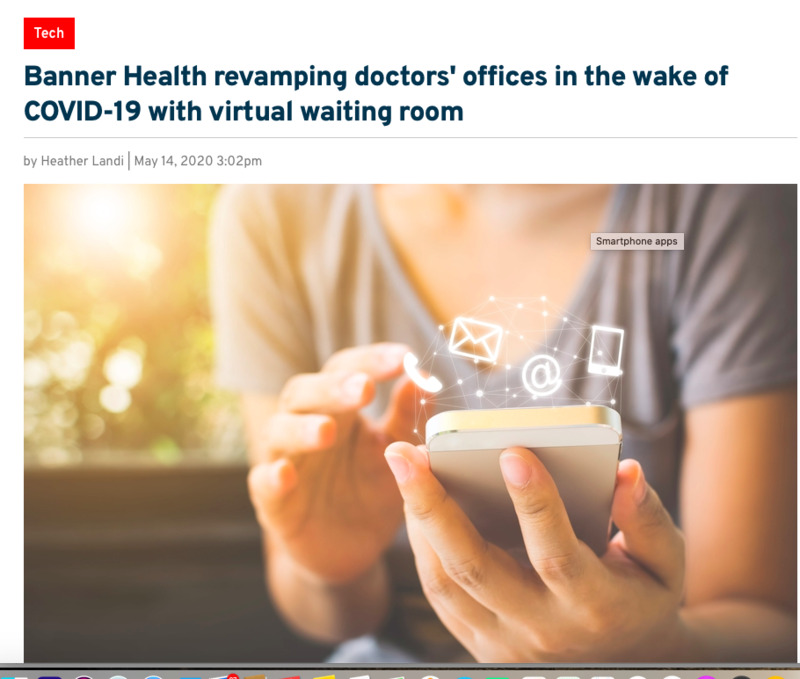
2020-05-14
An article describing Banner Health System's move towards virtual waiting rooms for doctors' visits.
-

2020-10-27
Preparing for a surge; Banner warns that things could be worse than in the summer.
-

2020-07
Our pets are a part of our family. So when their health is in jeopardy, it affects us all greatly. Early on in the pandemic, we had an emergency with our lovebird, Kermit. Our larger bird, an African Grey named Greycee, landed on top of Kermit's cage. Kermie proceeded to bite her toe through the cage bars, and Greycee bit back. Luckily we heard the scuffle and intervened immediately, but Greycee had created quite the puncture wound on Kermit's upper beak/nares. Normally these two are best buddies, so this was a suprising freak incident. I cleaned off Kermit's beak, but it looked bad and her breathing was shallow and rapid. Birds in respiratory distress can die rapidly. I rushed her to the emergency vet who told me that there was a 4 hour wait to be seen. I told them that Kermit wouldn't last 4 hours, so they agreed to see her immediately (for an additional fee of course) but I had to wait in the car. My already stressed and injured baby had to go into a strange place with strange people without her mom because of Covid. They stabalized her and sent her home for the night. I feared she wouldn't make it until the morning. Luckily, she pulled through the night. I called our vet immediately the next morning. It took several tries. Since you also had to wait in the car while there, and all conversations with the vet were over the phone, their phone lines were constantly busy. I finally got through, but they told me that despite the gravity of her condition there was no way they could get her in that day. Under normal circumstances they could, but with the new covid protocols every minute of every day was totally overbooked. I tried the emergency vet again and they had a 6 hour wait. You had to wait on site in your car too, which I couldn't do with my 4 year old daughter. Since Kermit is a bird, she cannot just go to any vet. There are only 2 avian vets in my area. I took a chance and called the other one and explained the situation. They were able to squeeze us in. Again I had to wait in the car and hand my baby off. She ended up staying the night. The blood from her wound had entered her lungs causing her breathing issues. She had recovered quite a bit by the next day, and the vet even allowed me in with social distancing and masks in order to show me how I needed to hand feed her for the next two weeks until her beak healed. At least because of the pandemic I was working from home at the time, so I could care for and monitor Kermit all day. Within a week she was back to her normal self.
In the fall, our Dog Evie went to the vet because a suspicious lump had grown on her toe. Evie is absolutely terrified of the vet. She is also deaf and has limited vision, so it is harder to comfort her. She needs our touch and our smell for reassurance. Of course, jsut as with Kermit, we could not go in with her. The vet techs had to carry her in because she was shaking so badly in fear. She needed to be sedated to do the biopsy of the lump. The report came back positive for cancer. She had to go back in again to have the whole toe removed as the biopsy had not gotten it all. This time she had to stay nearly all day and be pumped with anxiety meds to keep her asleep until the procedure. It was thankfully successful, but she also needed a follow up visit, so more meds. The whole experience was traumatizing for both our animals and us.
What's even worse is people were treated the same way.
-
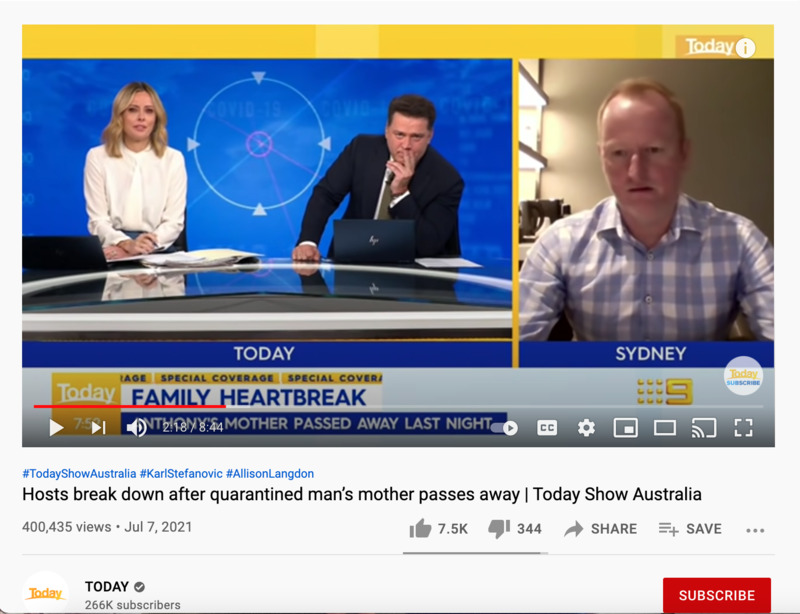
2021-07-07
This is a heartbreaking story from Australia about a man who flew around the world to try to get to his dying mother, only to have the Queensland government block his way. So many people across the globe had to die alone without their loved ones because of this pandemic. Hospitals and governments need to come up with a safe system to allow for visitation of dying relatives during pandemics because, sadly, this will likely happen again in the future.
-

2021-01-16
This story from Good Morning America talks about how 12.6 million households got new pets during the pandemic. Now some of those pets are not used to being alone. An expert trainer, Eric Ita, gives tips for pups with separation anxiety and other advice for dog owners.
-
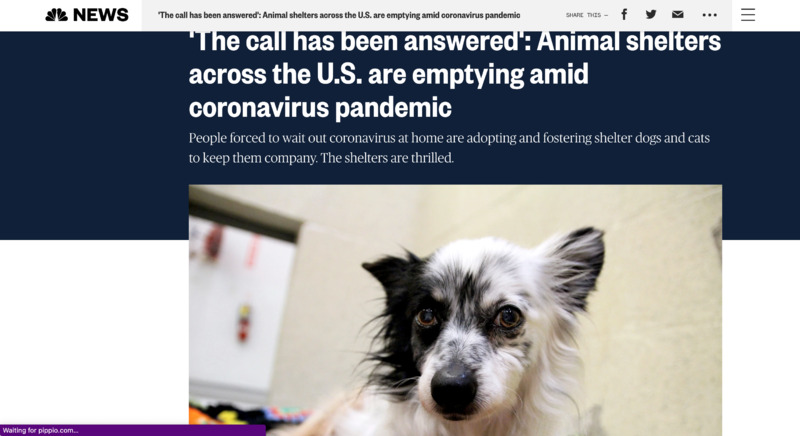
2020-04-19
The article discusses the surge of pet adoptions from shelters during the pandemic.
-
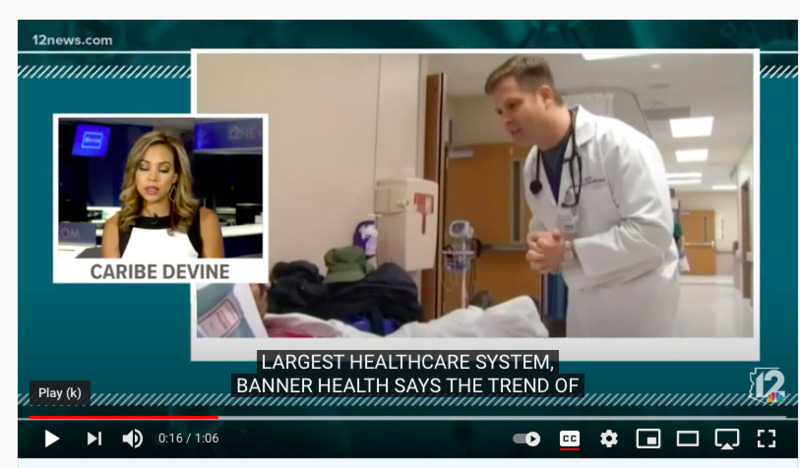
2020-06-05
Banner Health Chief Clinical Officer Dr. Marjorie Bessel told media Friday that intensive care units in Arizona were very busy.
-
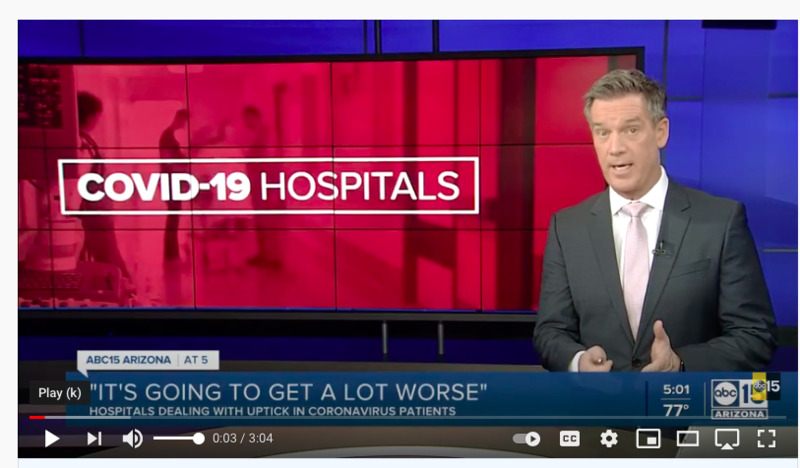
2020-12-09
Some doctors around the state are sounding the alarm on the number of available hospital beds - or lack thereof - as coronavirus cases surge.
-
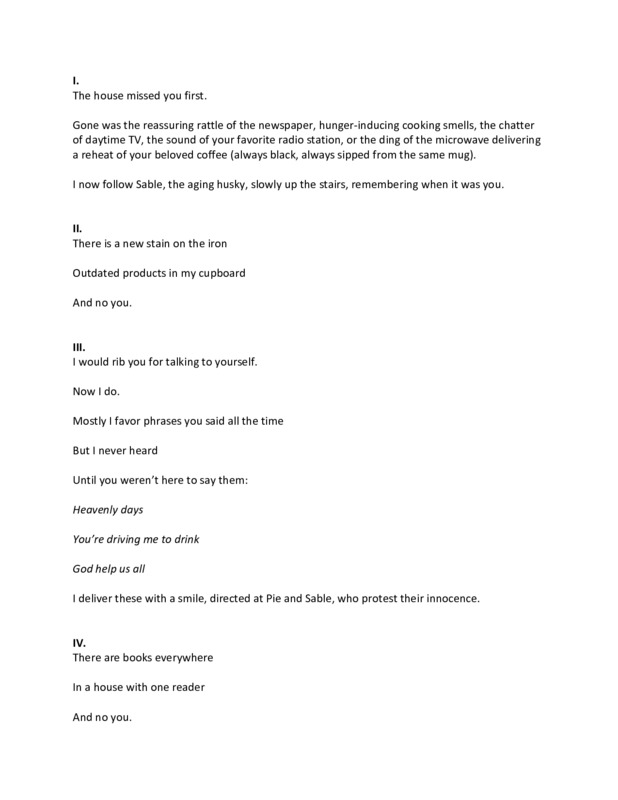
2021-07-16
My mom died of COVID-19 last July when her nursing home in Atlanta was overrun with the virus. Before that, she lived with me, my dog, and cat. The way she lived in the house made it truly a home for us. I am a workaholic, often using the house for a fast supper and some sleep before starting all over the next day, sprinting back to work. The poem is our way of telling her how much she is missed.
-
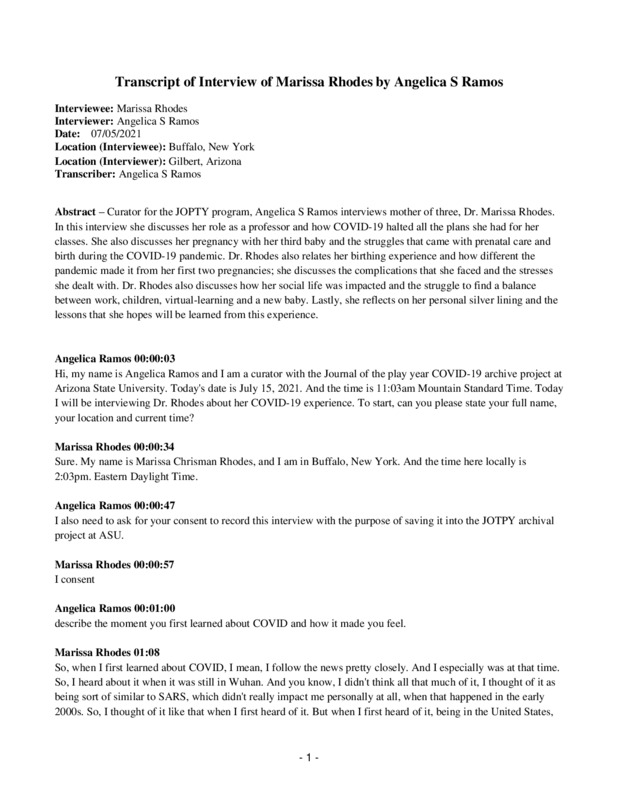
2021-07-15
Curator for the JOPTY program, Angelica S Ramos interviews mother of three, Dr. Marissa Rhodes. In this interview she discusses her role as a professor and how COVID-19 halted all the plans she had for her classes. She also discusses her pregnancy with her third baby and the struggles that came with prenatal care and birth during the COVID-19 pandemic. Dr. Rhodes also relates her birthing experience and how different the pandemic made it from her first two pregnancies; she discusses the complications that she faced and the stresses she dealt with. Dr. Rhodes also discusses how her social life was impacted and the struggle to find a balance between work, children, virtual-learning and a new baby. Lastly, she reflects on her personal silver lining and the lessons that she hopes will be learned from this experience.
-

2020-03
The pandemic was declared as I was en route to Ecuador. I was trapped in a strict lockdown isolated from any other travellers. My book describes my reactions and rescue. As a doctor I was not surprised that a pandemic was occurring as I knew that epidemiologists always say it is not an if but rather a when.
-
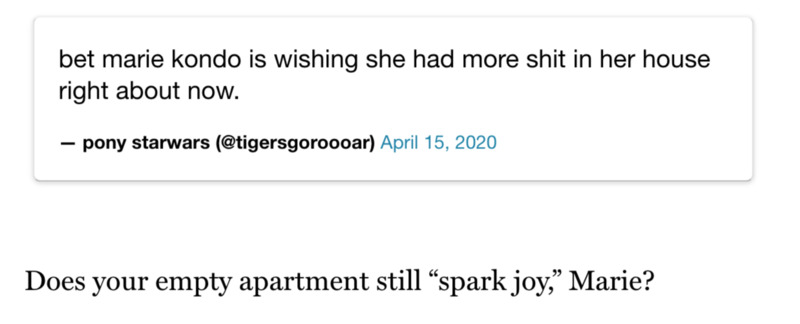
2020
During quarantine I collected many humorous memes about staying at home and the problems that brought. All sorts of subjects were covered: cooking, getting along with your spouse/roommates, homeschooling the kids, learning to bake bread, being stuck at home, sanitizing, facemasks, people hoarding toilet paper, boredom, effects of isolation, etc. Here are a few of those memes.
-

2020
During quarantine I collected many humorous memes about staying at home and the problems that brought. All sorts of subjects were covered: cooking, getting along with your spouse/roommates, homeschooling the kids, learning to bake bread, being stuck at home, sanitizing, facemasks, people hoarding toilet paper, boredom, effects of isolation, etc. Here are a few of those memes.
-
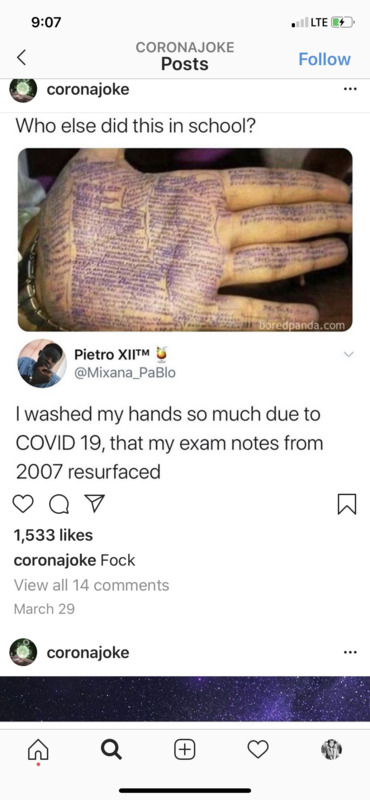
2020
During quarantine I collected many humorous memes about staying at home and the problems that brought. All sorts of subjects were covered: cooking, getting along with your spouse/roommates, homeschooling the kids, learning to bake bread, being stuck at home, sanitizing, facemasks, people hoarding toilet paper, boredom, effects of isolation, etc. Here are a few of those memes.
-
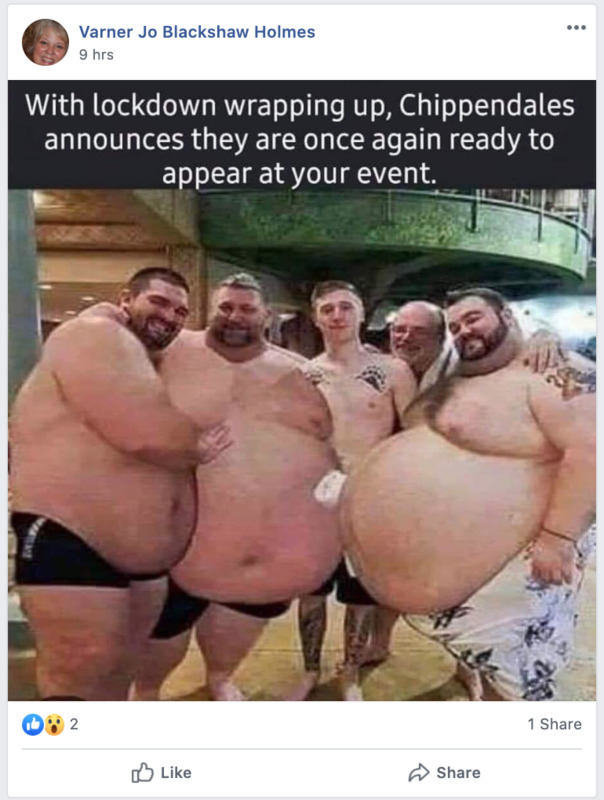
2020
During quarantine I collected many humorous memes about staying at home and the problems that brought. All sorts of subjects were covered: cooking, getting along with your spouse/roommates, homeschooling the kids, learning to bake bread, being stuck at home, sanitizing, facemasks, people hoarding toilet paper, boredom, effects of isolation, etc. Here are a few of those memes.
-
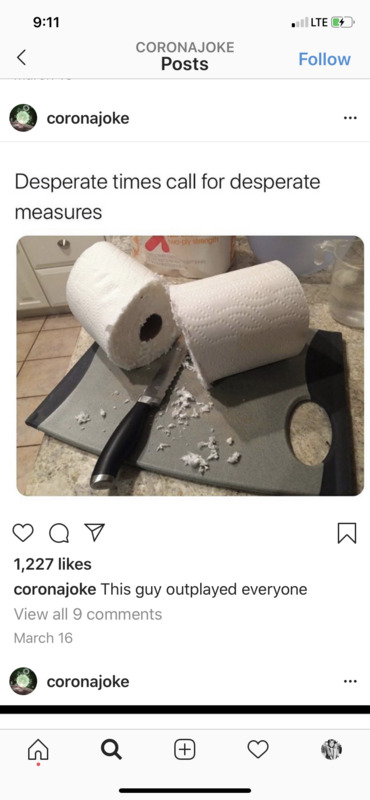
2020
During quarantine I collected many humorous memes about staying at home and the problems that brought. All sorts of subjects were covered: cooking, getting along with your spouse/roommates, homeschooling the kids, learning to bake bread, being stuck at home, sanitizing, facemasks, people hoarding toilet paper, boredome, effects of isolation, etc. Here are a few of those memes.
-

2020
During quarantine I collected many humorous memes about staying at home and the problems that brought. All sorts of subjects were covered: cooking, getting along with your spouse/roommates, homeschooling the kids, learning to bake bread, being stuck at home, sanitizing, people hoarding toilet paper, boredome, effects of isolation, etc. Here are a few of those memes.
-
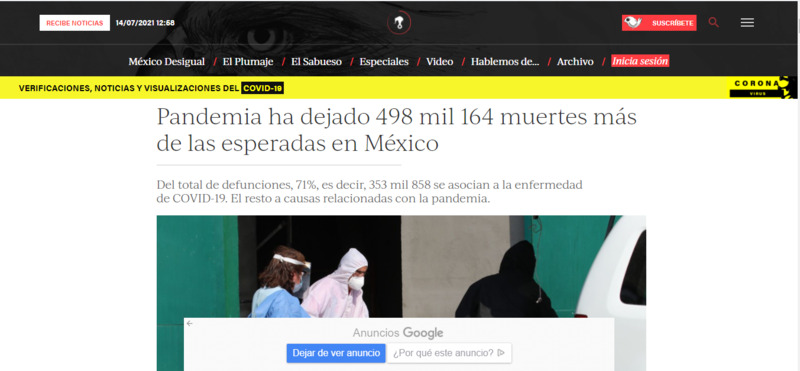
2021-07-14
México registra un exceso de mortalidad de 498 mil 164 personas fallecidas a lo largo de la pandemia de coronavirus. Del total, 71 por ciento, es decir, 353 mil 858 se asocian a la enfermedad de COVID-19 y el resto a otro tipo de causas.
De acuerdo con el reporte “Exceso de mortalidad en México” de la Secretaría de Salud, señala que, entre diciembre de 2019 y la semana epidemiológica 22 (que va del 30 de mayo al 5 de junio de 2021), se esperaba un millón 70 mil 79 muertes por distintas causas, pero el registro es de un millón 568 mil 243, es decir, 46.6% más.
Con respecto al género, el exceso de mortalidad se ha presentado principalmente en hombre con 319 mil 967 decesos, de los cuales 144 mil 703 tienen confirmación de muerte por SARS-CoV-2.
Mexico has an excess mortality of 498,164 people killed during the coronavirus pandemic. Of the total, 71 percent, or 353,858 are associated with COVID-19 disease and the rest are associated with other causes.
According to the report “Excessive mortality in Mexico” of the Ministry of Health, notes that between December 2019 and the 22nd epidemiological week (from May 30 to June 5, 2021), 70,079 deaths from different causes were expected. but the record is 568,243, that is, 46.6% more. With regard to gender, excess mortality has occurred mainly in men with 319,967 deaths, of which 144,703 have confirmed death by SARS-CoV-2.
-
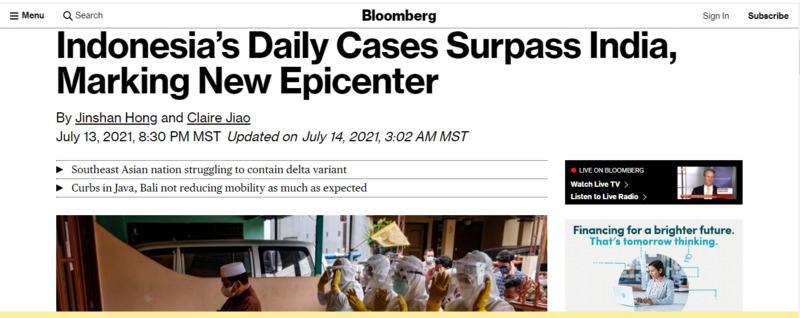
2021-07-13
Indonesia surpassed India’s daily Covid-19 case numbers, marking a new Asian virus epicenter as the spread of the highly-contagious delta variant drives up infections in Southeast Asia’s largest economy.
The country has seen its daily case count cross 40,000 for three straight days -- including a record high of 54,517 on Wednesday -- up from less than 10,000 a month ago. Officials are concerned that the more transmissible new variant is now spreading outside of the country’s main island, Java, and could exhaust hospital workers and supplies of oxygen and medication.
Indonesia’s current numbers are still far from India’s peak of 400,000 daily cases in May, and its total outbreak of 2.7 million is barely a tenth of the Asian giant’s 30.9 million. India, with a population roughly five times the size of Indonesia’s 270 million people, saw daily infections drop below 39,000 on Wednesday as its devastating outbreak wanes.
The Southeast Asian country reported about 900 deaths daily on average in the past seven days -- compared to just 181 a month ago -- while India reported an average of 1,027 daily fatalities.
-
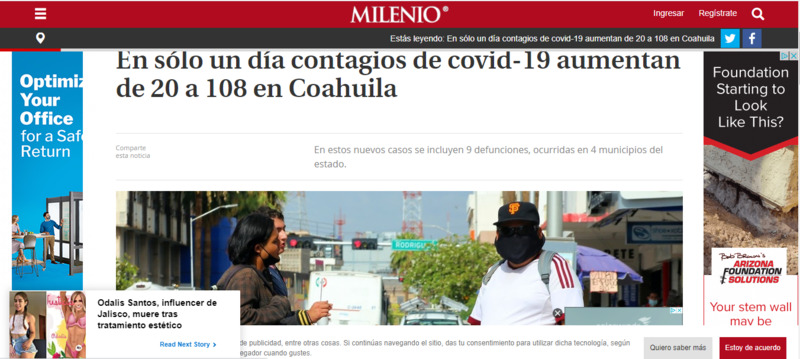
2021-07-14
La tercera ola de contagios de covid-19 parece haber llegado a Coahuila, toda vez que de golpe los nuevos casos subieron en las últimas 24 horas de 20 a 108, según el reporte diario de la Secretaría de Salud estatal.
En estos nuevos casos se incluyen 9 defunciones, ocurridas en 4 municipios del estado, que son liderados por Torreón en donde se registraron 5 de los decesos; en tanto que Saltillo reportó 2 y los municipios de Nava y Piedras Negras, uno en cada lugar; de ellos, sólo uno no estaba reportado como persona enferma.
The third wave of covid-19 infections appears to have reached Coahuila, as new cases suddenly rose in the last 24 hours from 20 to 108, according to the daily report of the state health department.
These new cases include 9 deaths, occurring in 4 municipalities of the state, that are led by Torreón where 5 of the deaths were recorded; while Saltillo reported 2 and the municipalities of Nava and Piedras Negras, one in each place; of them, only one was not reported as a sick person.
-

2021-07-14
The Los Angeles County Department of Public Health confirmed 1,103 new cases of Covid-19 on Tuesday. It’s the fifth consecutive day cases have been over 1,000. For perspective, one month ago, the 5-day average of cases was 201. Today the 5-day average is 1,095; this is an increase of more than 500% in just one month.
That increase has come even as testing has dropped precipitously, which means the actual rise of infections is likely much greater as there are fewer chances to identify cases.
-
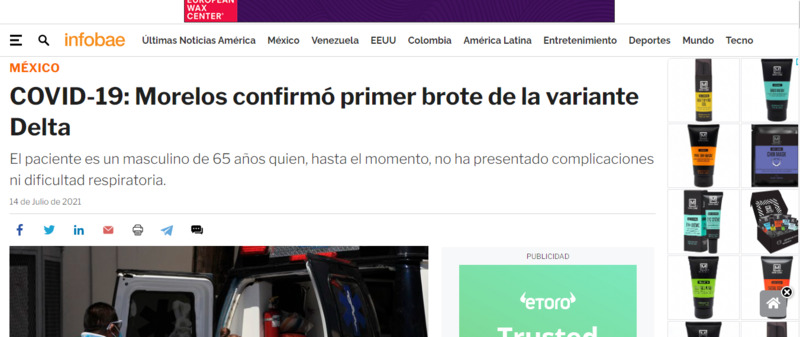
2021-07-14
Mexico - La Secretaría de Salud de Morelos confirmó el primer caso de COVID-19 de la variante Delta, la cepa con mayor índice de transmisión y cuyo acelerado crecimiento amenaza, principalmente, a la población joven de 20 a 39 años que no ha sido totalmente inmunizada o se encuentra en proceso de ello.
El paciente confirmado se trata de un masculino de 65 años de edad, quien actualmente recibe atención en una unidad del Instituto de Seguridad y Servicios Sociales de los Trabajadores del Estado (ISSSTE) sin reportar complicaciones ni dificultades respiratorias.
Mexico - The Ministry of Health in Morelos confirmed the first case of COVID-19 of the Delta variant, the strain with the highest transmission rate and whose rapid growth is mainly threatening to the young population aged 20 to 39 years who have not been fully immunized or are in the process of doing so.
The confirmed patient is a 65-year-old male, who is currently receiving care at a unit of the State Workers' Social Security and Services Institute there have been no reports of respiratory complications.
-

2021-07-14
Overdose deaths soared to a record 93,000 last year in the midst of the COVID-19 pandemic, the U.S. government reported Wednesday.
That estimate far eclipses the high of about 72,000 drug overdose deaths reached the previous year and amounts to a 29% increase.
"This is a staggering loss of human life," said Brandon Marshall, a Brown University public health researcher who tracks overdose trends.
The nation was already struggling with its worst overdose epidemic but clearly "COVID has greatly exacerbated the crisis," he added.
Lockdowns and other pandemic restrictions isolated those with drug addictions and made treatment harder to get, experts said.
-
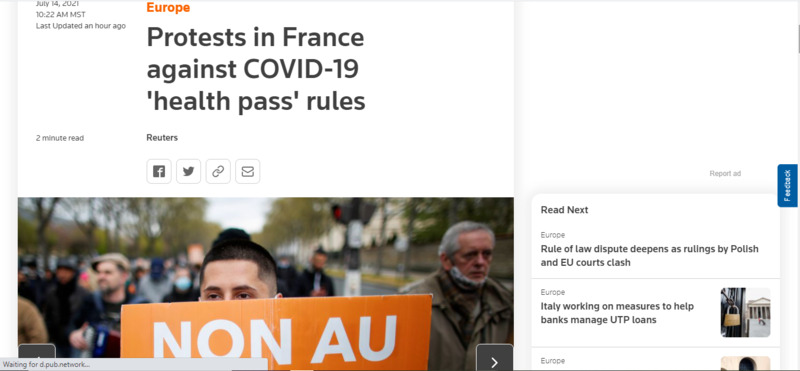
2021-07-14
Police in Paris clashed with protesters railing against President Emmanuel Macron's plan to require a COVID-19 vaccine certificate or negative PCR test to gain entry to bars, restaurants and cinemas from next month.
Macron this week announced sweeping measures to fight a rapid surge in new coronavirus infections, including the mandatory vaccination of health workers and new health pass rules for the wider public.
In doing so, he went further than most other European nations have done as the highly contagious Delta variant fans a new wave of cases, and other governments are watching carefully to see how the French public responds.
-
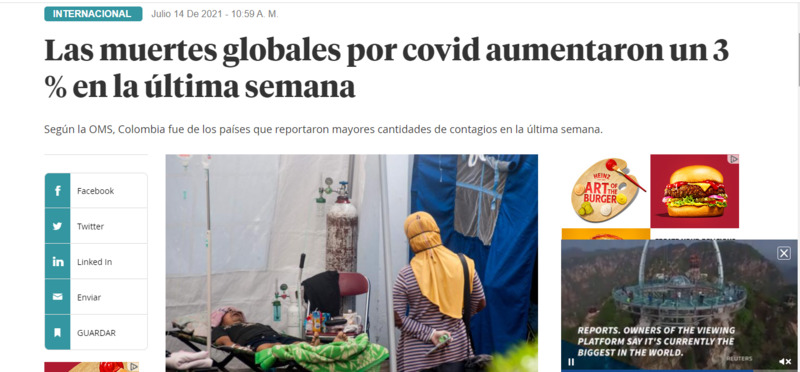
2021-07-14
ras nueve semanas consecutivas de descensos en el número de muertes globales por covid-19, del 5 al 11 de julio se registró un aumento del 3 % con respecto a la semana anterior, con más de 55.000 fallecimientos, según el informe epidemiológico semanal de la Organización Mundial de la Salud (OMS).
After nine consecutive weeks of declines in the number of global deaths from COVID-19, there has been an increase of 3% from 5 to 11 July compared to the previous week, with more than 55,000 deaths. According to the World Health Organizations' (WHO) weekly epidemiological report.
-
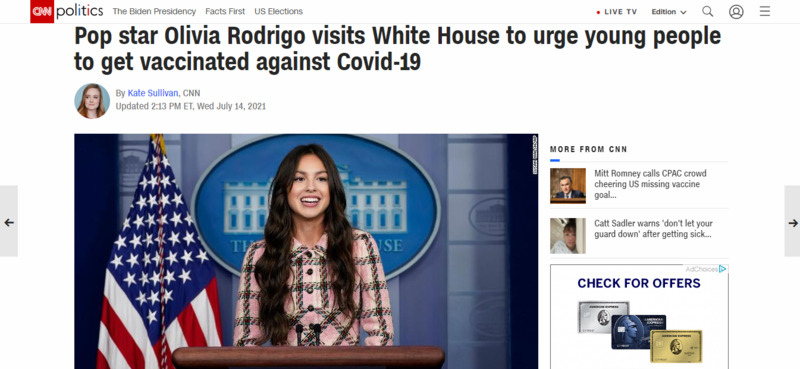
2021-07-14
"I am beyond honored and humbled to be here today to help spread the message about the importance of youth vaccination," Rodrigo said from the White House press briefing room podium. Youth vaccination rates continue to lag significantly behind the general American population.
Rodrigo continued: "I'm in awe of the work President Biden and Dr. Fauci have done and was happy to help lend my support to this important initiative. It's important to have conversations with friends and family members encouraging all communities to get vaccinated, and actually get to a vaccination site, which you can do more easily than ever before, given how many sites we have and how easy it is to find them at vaccines.gov."
The videos will be featured on the 18-year-old's social media channels as well as the White House's accounts. Rodrigo is the singer of hits "Drivers License," and "good 4 u," and has more than 28 million followers across her channels.
-

2021-07-14
Olivia Rodrigo arrives at the White House to record videos promoting covid-19 vaccines. She'll meet with President Biden and Dr. Anthony S. Fauci.
This Facebook comment feed shows a mixed reaction to President Biden's latest effort to get young people vaccinated.
-
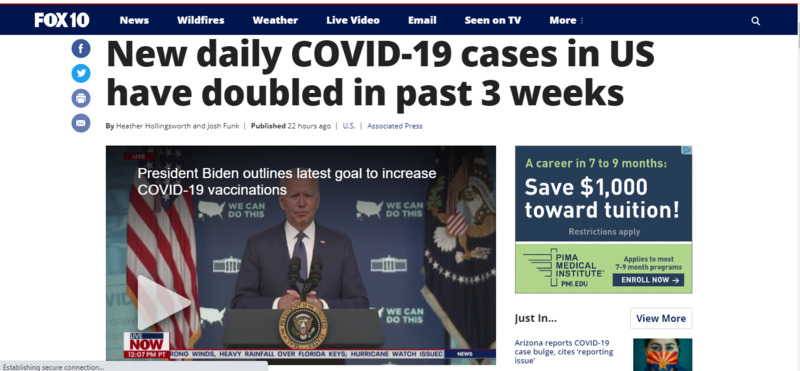
2021-07-13
The COVID-19 curve in the U.S. is rising again after months of decline, with the number of new cases per day doubling over the past three weeks, driven by the fast-spreading delta variant, lagging vaccination rates and Fourth of July gatherings.
Confirmed infections climbed to an average of about 23,600 a day on Monday, up from 11,300 on June 23, according to Johns Hopkins University data. And all but two states — Maine and South Dakota — reported that case numbers have gone up over the past two weeks.
-

2021-07-14
As life goes back to normal (whatever that means) here in the United States I fear that we are all turning a blind eye to the truth, COVID is not gone. Hand sanitizing stations are no longer being refilled in most places and we can go grocery shopping without masks, restaurants are busy and people are getting back to work. This would all be good news if globally our numbers continued to decline. The truth is that growing variants, like the Delta variant, are causing numbers to rapidly rise. Here in the US we have become so comfortable with life back to "normal" that we have become complacent. We are not yet safe, people are still dying.
-
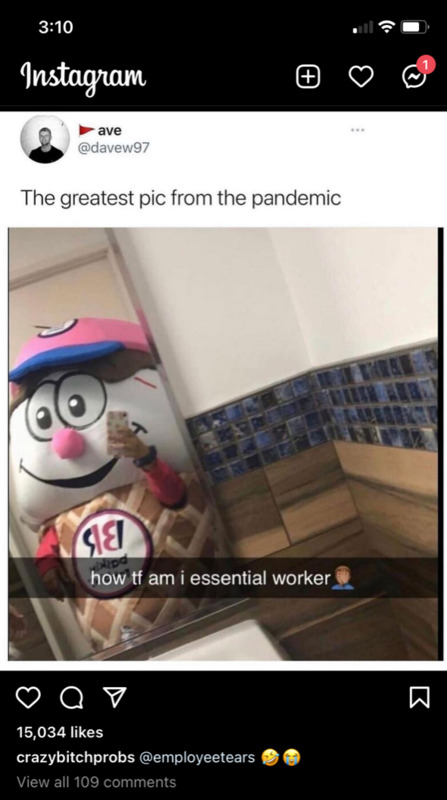
2021-07-13
Most people think of essential workers as public servants, mainly hospital staff but this picture shows that there were some unexpected jobs that were at one point labeled essential.
This photo got some unexpected comments on Instagram like this one - "In that dark time, you helped people stay positive thru a pandemic man! That was the most essential work then." And this other one "But ice cream was essential during the pandemic! It was basically my only reason to live for a lil while." A lot of people found this picture funny but surprisingly many were quick to point out that it was the simple things, like mascots and ice cream, that kept us all smiling.
-
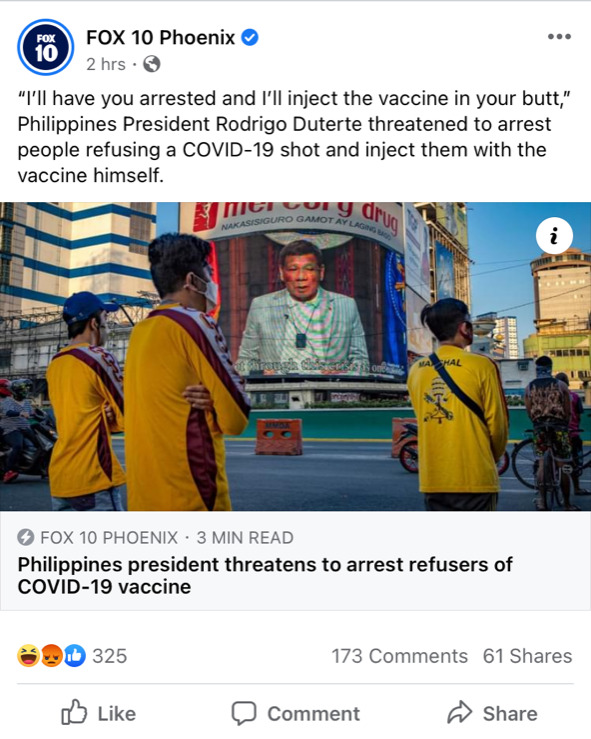
2021-06-24
MANILA, Philippines - Philippines President Rodrigo Duterte on Monday threatened to imprison citizens who refuse to get a COVID-19 vaccine as the nation continues to be a hotspot for the novel coronavirus in Asia.
The country has recorded more than 1.3 million COVID-19 cases and over 23,000 deaths.
-
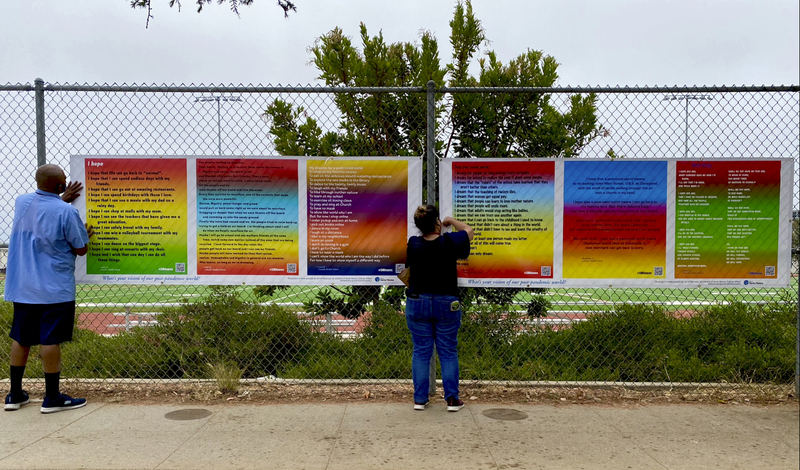
2021-07-12
These banners were made from submissions to the #SMhopes call on this site, and displayed around the City of Santa Monica in the Spring and Summer of 2021. Designed by Paula Goldman and supported by a grant from Art of Recovery, an initiative of Santa Monica Cultural Affairs.
-

2020-05-24
Global death rate per 100,000
-

2021-07-11
Disagreement with Biden over Afghanistan
-
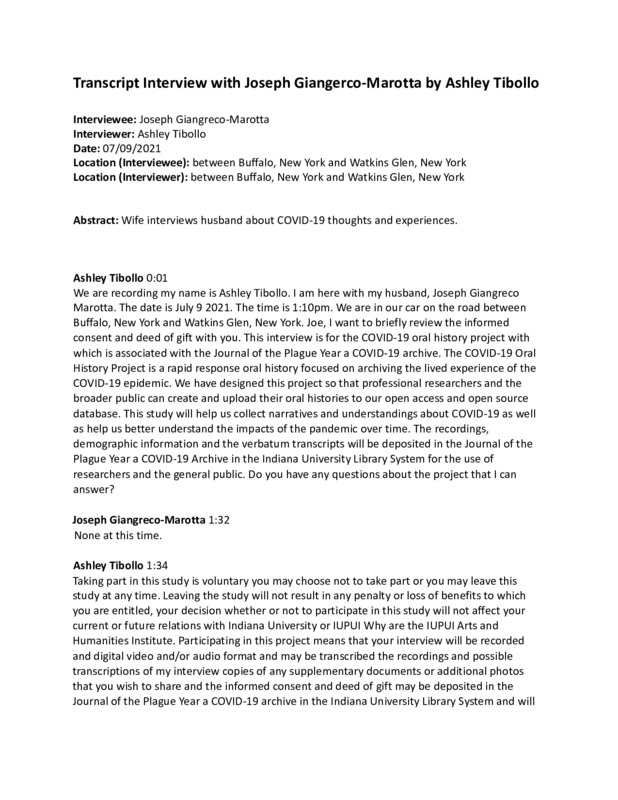
07/09/2021
Wife interviews husband about COVID-19 experience.
-
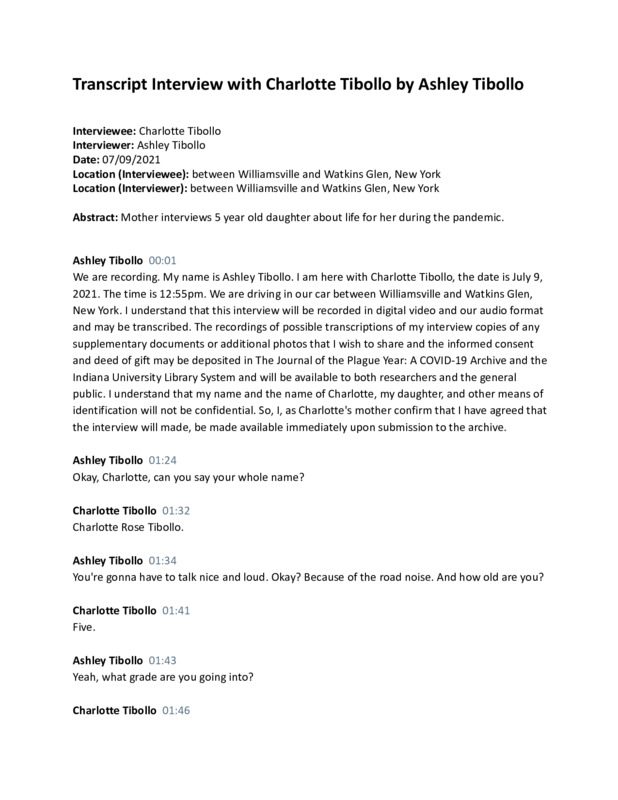
2021-07-09
Mother interviewing 5 year old daughter about the pandemic.
-
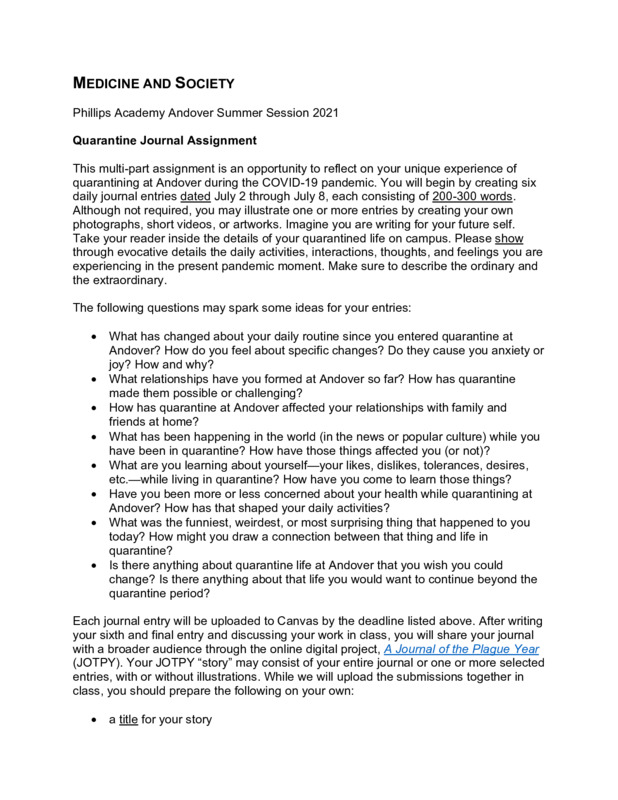
2021-07-10
While students in the 2021 on-campus summer program at Phillips Academy Andover quarantined on campus for one week, I asked those enrolled in my "Medicine and Society" course to keep a journal in which they reflected on how their daily experiences were shaped by the program's COVID protocols. Those protocols included universal masking (indoors and outdoors), social distancing, grab-and-go food service, regular PCR testing, and more. For their JOTPY stories, some students chose to upload their entire journals, while others summarized their reflections over the week. On the day we uploaded our stories, the quarantine period came to end, and the students could enjoy a bit more social freedoms on and off campus.
-
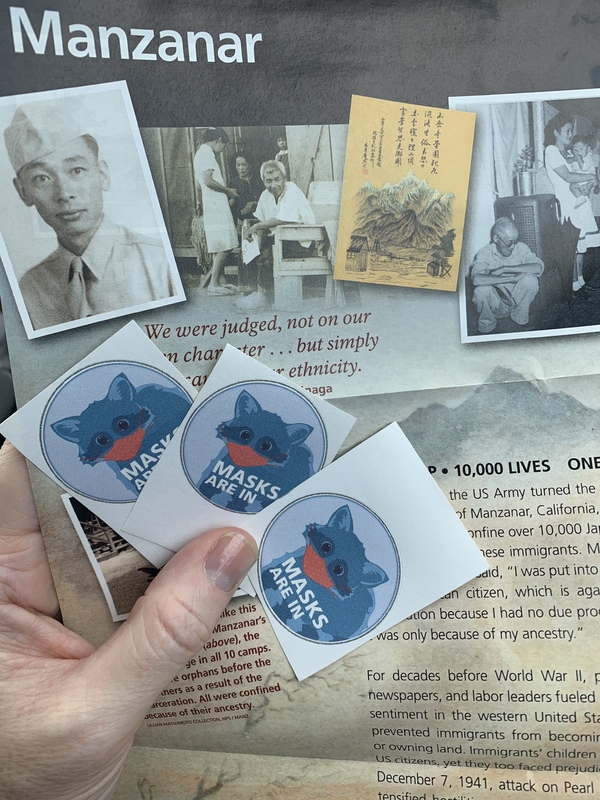
2021-07-10
As a historian, US History teacher, and mother of two Asian-American children, I make a point to expose my children to all aspects of America’s history: good, bad, and ugly. Thanks to COVID, we had the opportunity to show the kids one of the country’s ugliest moments - Japanese internment. The desolate desert in the middle of our home state is an area I had never driven through before COVID, despite having lived in CA my entire life and being (supposedly) 8th or 9th generation Californian on my dad’s side. However, there is no way I’m putting my family on an airplane during a pandemic, which limits vacation options. So into the car for an eight hour drive to Tahoe. A drive that goes right past Manzanar, the Japanese American World War II concentration camp. Unlike last year, when we made the same drive for the first time in my life, the exhibits, buildings, and visitor center were open with masks and social distancing. As we stood in the barrack in the 106 degree temperature, I told my kids to never forget how uncomfortable they felt and to consider the fact that they were feeling awful from the heat as tourists. I told them to imagine living in this heat as a prisoner though you committed no crime except having ancestors from Japan. They may be young, but they are old enough to understand human rights. Visiting Manzanar was overwhelming. I am not a very emotional person, but I was taken aback by the fact that this history is so recent. My best friend’s dad was born in Tule Lake, where Japanese-Americans who refused to take the forced loyalty oath were sent. That is only one generation before mine. Seeing and experiencing second hand through family and friends the hatred directed toward Asian-Americans during this pandemic made the experience in Manzanar extra raw. Though I refuse to thank COVID for anything because I think that’s a bit tone deaf for all who have lost and suffered during this pandemic, I am grateful that the circumstances that led us to drive to Tahoe instead of fly led us also to a place of reflection on prejudice and race, especially in the climate of today.
-
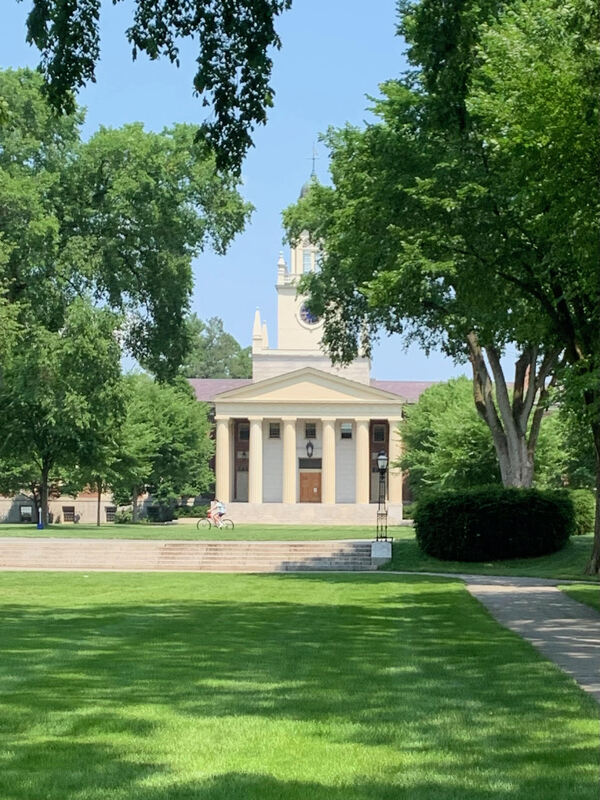
2021-07-10
Coming to Phillips Academy Andover Summer Session during the quarantine phase of the school helped me notice a positive thing Covid had brought at the boarding school. Along with a funny story to help cheer everyone up.
-
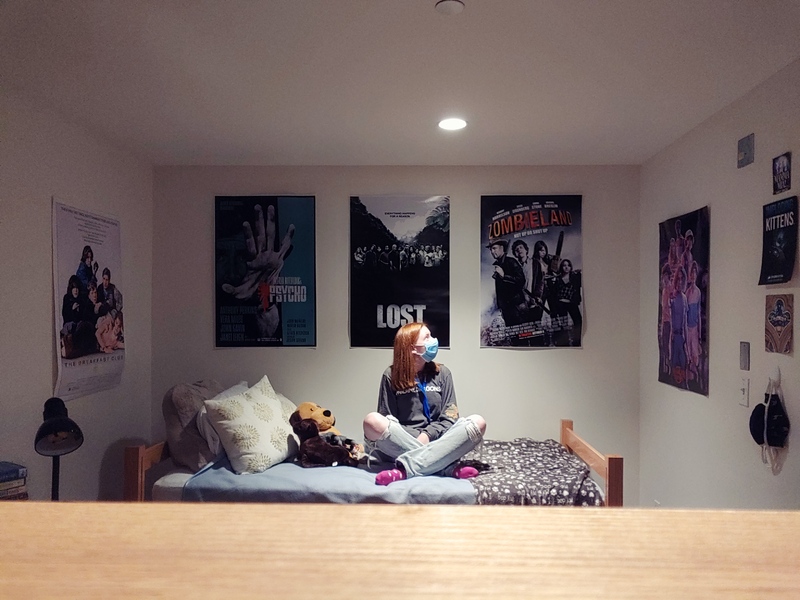
2021-07-10
I tried something new. And that’s not something that I do often. I pushed myself to go to boarding school… During a pandemic. I spent one (Covid safe) month at a boarding school and kept a journal every night for the first week. Here’s my experience of sweaty masks, making friends, and living in my dorm.
-

2021-07-10
My name is Maya Watt, I am 17 and I am from Memphis, TN. I am currently attending Phillips Academy Andover during their Andover Summer program before senior year. I have met many people, learned new things, and worked on my worth ethic. This is the story of my quarantine during my first week and a half at the camp. There are some highs and lows, but throughout my slightly rough quarantine/transition into the camp, I realized the purpose of my attendance at this school.
-
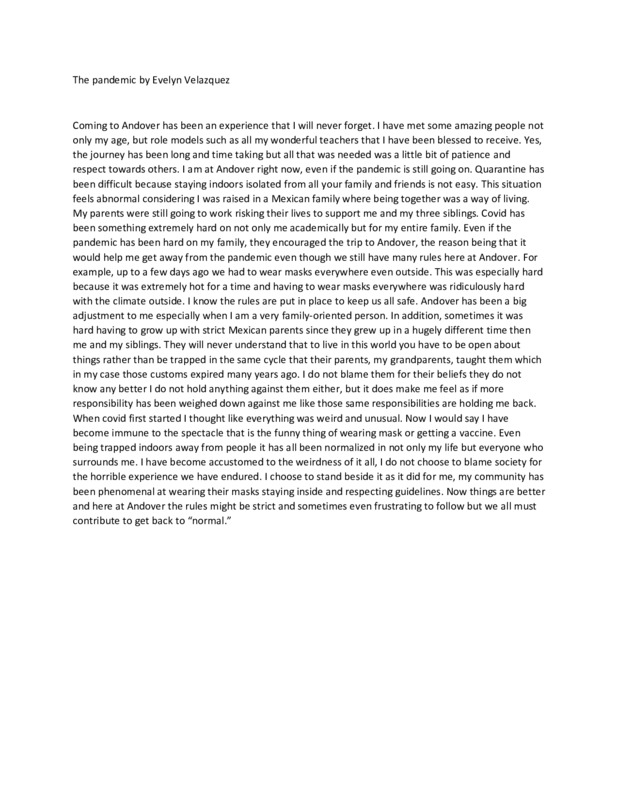
2021-07-10
My story talks about the pandemic and how being a teenager in the time of the pandemic has been extremely difficult considering I am a women of color going through a pandemic.
-

2021-07-10
My submission to the Journal of the Plague Year is a reflection on the process of writing diary entries about living through a quarantine period at my summer program at Phillips Academy Andover. It talks through my feelings of anxiety and guilt, as well as feeling a sense of distance from the rest of the world during the seven day period, and explains how keeping a diary can help you understand your own emotions during a difficult time.
-
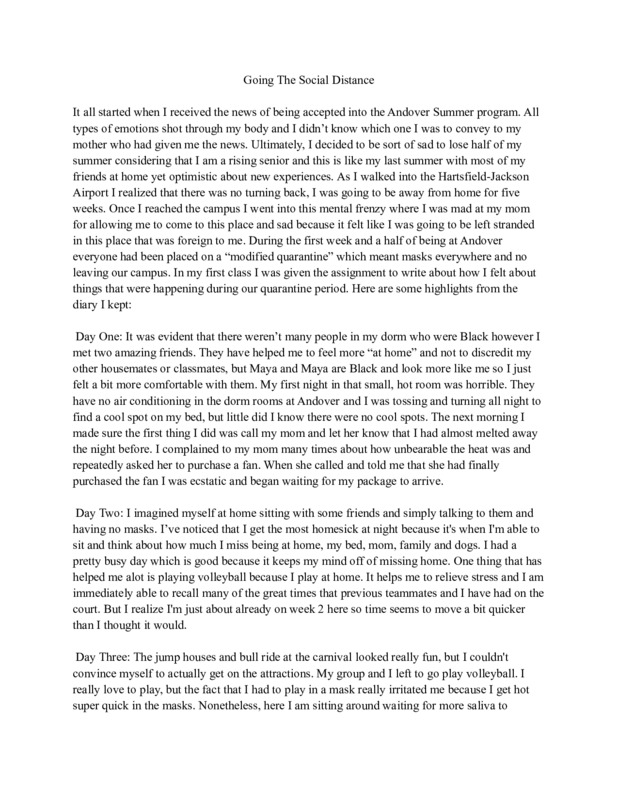
2021-07-10
Over the course of about a week and a half I share my thoughts and feelings about the restrictions and rules we had while being placed on a modified quarantine. I discuss how it was to survive in the heat of summer, play volleyball, go to classes, and many other things while being masked up all the time. I tell readers about the testing I had to do so that everyone should know that I was negative for covid even. My story shows the different stages I've gone through throughout this modified quarantine. The stages being homesick to becoming comfortable embracing this experience of a lifetime. It is important to me because I'm using my real feelings and letting the readers know how I truly felt during the experience.
-
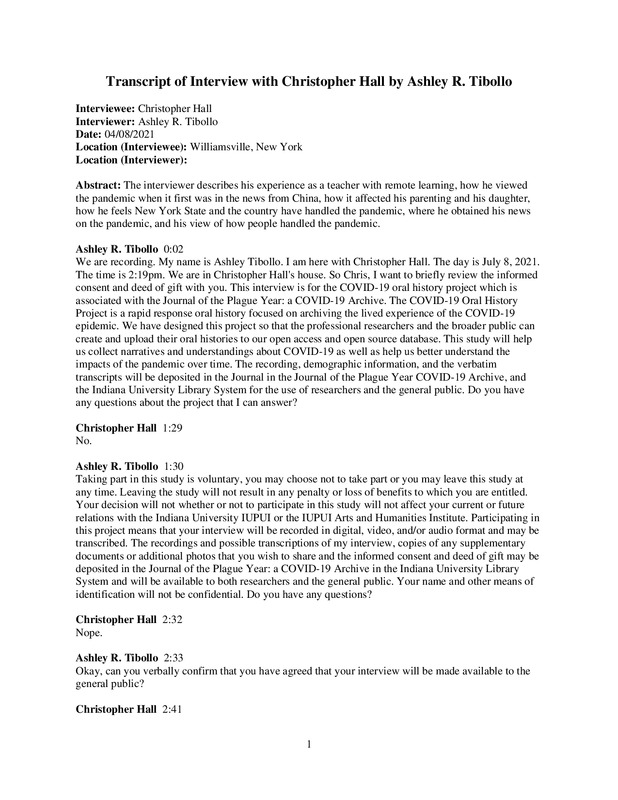
07/08/2021
The interviewer describes his experience as a teacher with remote learning, how he viewed the pandemic when it first was in the news from China, how it affected his parenting and his daughter, how he feels New York State and the country have handled the pandemic, where he obtained his news on the pandemic, and his view of how people handled the pandemic.
-
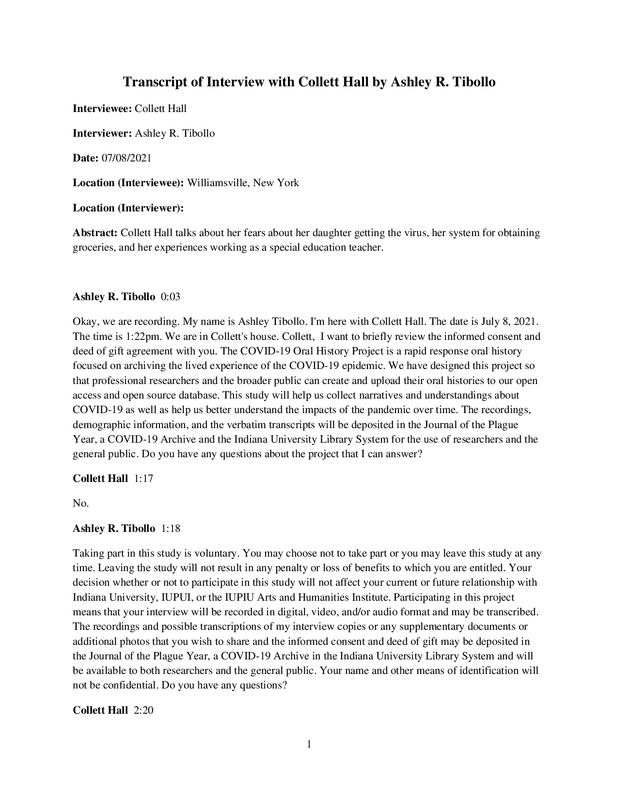
07/08/2021
Collett Hall talks about her fears about her daughter getting the virus, her system for obtaining groceries, and her experiences working as a special education teacher.
 2020
2020 2020
2020 2020-06-30
2020-06-30 2020-05-14
2020-05-14 2020-10-27
2020-10-27 2020-07
2020-07 2021-07-07
2021-07-07 2021-01-16
2021-01-16 2020-04-19
2020-04-19 2020-06-05
2020-06-05 2020-12-09
2020-12-09 2021-07-16
2021-07-16 2021-07-15
2021-07-15 2020-03
2020-03 2020
2020 2020
2020 2020
2020 2020
2020 2020
2020 2020
2020 2021-07-14
2021-07-14 2021-07-13
2021-07-13 2021-07-14
2021-07-14 2021-07-14
2021-07-14 2021-07-14
2021-07-14 2021-07-14
2021-07-14 2021-07-14
2021-07-14 2021-07-14
2021-07-14 2021-07-14
2021-07-14 2021-07-14
2021-07-14 2021-07-13
2021-07-13 2021-07-14
2021-07-14 2021-07-13
2021-07-13 2021-06-24
2021-06-24 2021-07-12
2021-07-12 2020-05-24
2020-05-24 2021-07-11
2021-07-11 07/09/2021
07/09/2021 2021-07-09
2021-07-09 2021-07-10
2021-07-10 2021-07-10
2021-07-10 2021-07-10
2021-07-10 2021-07-10
2021-07-10 2021-07-10
2021-07-10 2021-07-10
2021-07-10 2021-07-10
2021-07-10 2021-07-10
2021-07-10 07/08/2021
07/08/2021 07/08/2021
07/08/2021